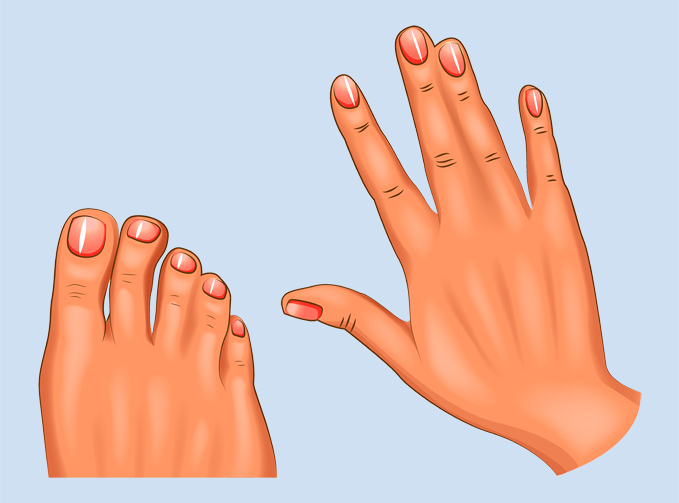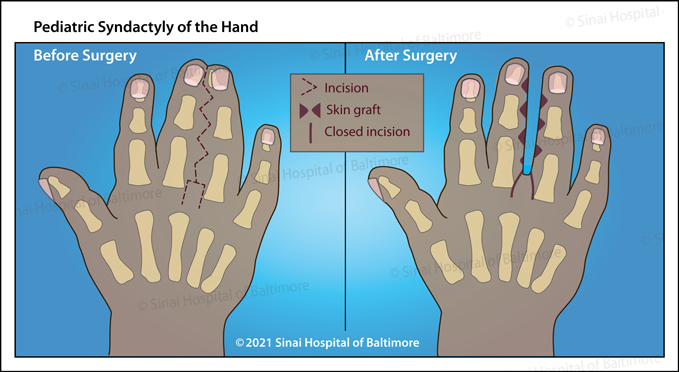Syndactyly
What is syndactyly?

Syndactyly is a condition characterized by webbed or fused fingers or toes. Sometimes this condition is referred to as webbed or conjoined fingers or toes (digits). The term syndactyly is derived from the Greek prefix syn- (“with, together”) and the Greek noun daktylos (“finger, digit”).
Syndactyly presents at birth, in which two or more digits are joined together causing a fused or web-like appearance. Most often the webbing effects the second and third digits, but it can affect any of the digits, including the thumb and big toe. There are four different types of syndactyly:
- Simple syndactyly: the digits are webbed or joined skin only;
- Complex syndactyly: in addition to the skin, the bones of adjacent fingers/toes are fused together;
- Complete syndactyly: the webbing involves the full length of the connected digits;
- Incomplete or partial syndactyly: the webbing involves just part of the length of the connected digits.
There is also a related condition called symbrachydactyly, where the digits are webbed and short. Sometimes a child with symbrachydactyly may have fewer than five fingers or toes on a limb.
How are patients affected and what challenges do they face?
The function and appearance of the hand and feet vary between children born with syndactyly. Children with syndactyly of the hand may not be able to spread their fingers apart wide enough to grasp large objects. The more digits that are involved and missing, the greater the challenge is for the child. The function of feet with syndactyly is generally not affected. However, the appearance of the affected hands and feet can lead to self-esteem challenges because of the way the child feels about his or her hands and feet and the way people react to his or her condition.
What causes syndactyly?
During development, the fetus in the womb initially has all digits joined together. Usually, by the end of the second month of pregnancy, the spaces between the fingers and toes open, and the web appearance disappears. However, sometimes the webbing remains, and the child appears at birth with the congenital deformity of syndactyly. Sometimes the digits themselves are short due to a constriction band syndrome. In most cases, when a child is born with syndactyly, there is nothing a parent could have done to cause or prevent this condition.
How common is syndactyly?
Syndactyly is one of the most common congenital limb malformations occurring in every 3–10 babies out of every 10,000 births, although higher estimates have been reported. Feet are more frequently involved with syndactyly than the hands, and males are affected twice as often as females.
How is syndactyly diagnosed?
Clinical examination of a patient with webbed or fused digits should include an X-ray to determine the extent of the syndactyly condition. Occasionally, syndactyly is only part of a group of health issues, such as Apert syndrome or Saethre-Chotzen syndrome. Therefore, a child with syndactyly requires a comprehensive medical review to evaluate the total patient’s needs.
What are the treatment options for syndactyly?
Webbed toes do not usually need to be treated, because they rarely cause any functional problems. Timing for the surgical treatment of children—dividing the fingers—can vary according to the extent of the webbing and the priorities of any other medically necessary treatments. Early treatment of the webbed fingers encourages optimal function. Coordination, grip and the ability to pinch all develop before the age of twelve months and continue to develop until the age of three years. Therefore, if the webbing involves the middle fingers, surgical treatment is recommended between 18-24 months. If the thumb and index finger are involved, surgical treatment is recommended before the patient is six months old. Most patients only require one surgery which includes skin grafts or skin flaps to cover the newly exposed areas of the fingers.
 During surgery, a zigzag incision is made to separate the two webbed digits because the skin surrounding the two joined digits is not enough to cover them after they are separated. Straight line incisions also tend to scar in a band that contracts over time. The surgeon then applies skin grafts to cover the newly exposed areas of the digits.
During surgery, a zigzag incision is made to separate the two webbed digits because the skin surrounding the two joined digits is not enough to cover them after they are separated. Straight line incisions also tend to scar in a band that contracts over time. The surgeon then applies skin grafts to cover the newly exposed areas of the digits.Why choose the International Center for Limb Lengthening for treatment of syndactyly?
Your doctor at the International Center for Limb Lengthening will take the time to make sure you understand all of your options and then will customize your treatment to meet your specific needs. Our patients benefit from our team-centered approach with world-renowned surgeons and specialized physician assistants, nurses and physical therapists. We help patients with syndactyly achieve their best possible result.
Doctors who treat syndactyly
◊Hand Only

